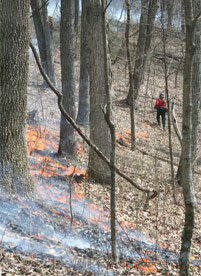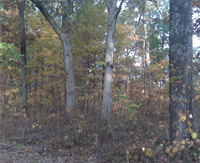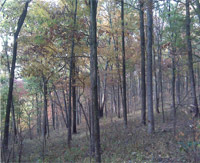Main Content
Article
Little Blue Creek Oak Restoration Project: Brown County State Park
 There are many types of forests in Indiana. Oak forests intermixed with other forest types across the landscape provide diverse habitat for wildlife. Mast crops such as acorns from oaks and nuts from hickories are among the most valuable food sources for many animals. Other plants common to oak forests such as grasses and sedges contribute as well.
There are many types of forests in Indiana. Oak forests intermixed with other forest types across the landscape provide diverse habitat for wildlife. Mast crops such as acorns from oaks and nuts from hickories are among the most valuable food sources for many animals. Other plants common to oak forests such as grasses and sedges contribute as well.
Oak forests are becoming rarer due in part to changing land uses and decades of fire suppression. Oaks and other sun-loving grasses and flowers require sunlight to thrive and reproduce. Without periodic disturbances, such as storms or wildfires, that allows sunlight to fill a forest from top to bottom, more shade-tolerant trees and shrubs begin to grow in the increasing shade and eventually replace the original forest. Though this is the natural order of things, historic forests would regularly “reset” themselves after a disturbance caused by wind, pests, or fires both natural and human caused.
Since the establishment of Brown County State park in 1929 and the majority of our other state parks, both natural and man-made disturbances have been lacking. Fires have been suppressed for decades and no major management has been performed on the aging forests. Many historic oak forests are being replaced by other forest types in specific areas, resulting in less habitat diversity and reflection of original conditions.
Starting in 2009, the DNR’s Division of State Parks and Reservoirs along with other DNR divisions, The Nature Conservancy, and local fire and EMS departments strategically began burning a semi-remote 1400 acre tract in the park. Again the overall goal was to establish conditions in which a more open, woodland forest community could thrive. The prescribed fire had a three-tiered approach; first the fire would induce stress and caused mortality of shade tolerant species, the second tier of this fire was to reduce leaf littler and expose mineral soils to favor germination of desirable species, and finally the fire will reduce or clear thorny shrubs which compete with oaks for resources.
Prescribed fires do not have an overnight effect, other than blackening the area that was burned. Within a few weeks, the trained eye will begin to see a subtle difference. To achieve maximum effectiveness from a prescribed fire, this area at Brown County State Park will have to be burned routinely for the next 8-10 years. At the end of that time period, a more open oak woodland will begin to prevail. Combined with similar efforts of other nearby groups and agencies, oak restoration at Brown County State Park will contribute to a regional scale of wildlife benefits.
The following two photos illustrate the difference between burned areas of the project and adjacent areas not burned. The area on the left has not been burned. The area on the right was burned in 2009.

Non-burned area

Burned area
